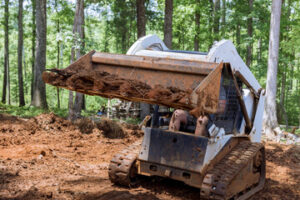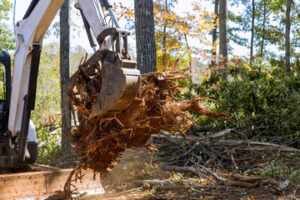The right Excavating Contractor is an essential part of any construction project. They clear the area of troublesome obstacles such as trees, logs, roots and boulders. They trench for foundations and pools, and grade and smooth the soil.

They also ensure the terrain matches the required elevations outlined in the plans. Using the proper machinery, they achieve their task with great accuracy and precision.
One of the most important services offered by an excavation contractor is levelling, which ensures that the ground meets the specifications outlined in construction plans. This is crucial to the success of a building project and helps reduce structural instability later on. It is also necessary to prevent water pooling, which can cause drainage problems and even foundation damage.
During levelling, the excavating contractor uses heavy machinery to adjust the ground’s elevation. It may require grading and soil compacting to achieve the desired outcome. Moreover, it is necessary to identify and mark regions where earthworks are required. In addition, the contractor must prepare the site for utility installation. This involves digging narrow excavations and laying pipes and cables. It must be done correctly to avoid damaging existing underground utilities.
Other services offered by excavation companies include land preparation and demolition. They are also responsible for clearing sites and ensuring that they are safe to work on. They may also build temporary or permanent roadbeds to facilitate the movement of large equipment and materials.
Excavation contractors use a variety of vehicles to transport their equipment. These include pickup trucks and tractor-trailer combos. Some contractors may choose to hire a third party to move their equipment, especially if it is too large for their vehicles. This can be costly and exposes businesses to a number of risks, such as Federal Motor Carrier Safety Administration compliance and load securement concerns.
The excavation industry provides a wide range of job opportunities for both new and experienced workers. Entry-level positions offer modest pay, while skilled workers can earn up to six-figure salaries in managerial or specialized roles.
Choosing the right excavation contractor for your project requires careful consideration of the following factors: Experience and reputation: Look for a company with extensive experience in the field. This will allow them to manage complex projects efficiently and effectively. Inquire about their safety commitment and client references to gauge their reliability. Finally, consider the quality of their equipment and technology and ask about their cost transparency. A reliable and competent excavation contractor will be upfront about the costs involved, making them more likely to stick to their budget.
Retaining Walls
Retaining walls are structures built to restrain soil or engineering fill at an angle steeper than the material’s natural inclination. They are often used in landscaping, civil engineering and road construction to stabilize slopes or prevent soil erosion. In residential landscapes, retaining walls provide an aesthetic solution for homeowners with sloped yards. They also help reduce the grade of driveways, parking areas and other surfaces to make them safer and easier to use.
Hiring a contractor that specialises in excavation is the best way to ensure your project runs smoothly and efficiently. This is because they will have a thorough understanding of how the different types of soil react to digging and will be able to work with them accordingly. Professionals also have the experience and equipment to work around existing structures and utilities that are on or near the site of your excavation project.
Another benefit of hiring a contractor that specialises in excavation is that they will be able to help you navigate the often complicated process of obtaining permits and meeting deadlines for your construction project. This is because excavating contractors can offer their expertise in interpreting architectural and engineering specifications, preparing the excavation site, and working with permitting services and utility companies to get your project up and running on time.
Lastly, when choosing an excavating contractor to complete your project, be sure to consider their reputation and customer reviews. Look for contractors with a solid history of providing quality work on-time and within budget. Ask for a detailed project proposal and client references to gauge their level of professionalism and commitment to meeting your specific excavation needs.
While you may be tempted to hire inexperienced individuals to handle your excavation projects, this could actually end up costing you more in the long run. Inexperienced individuals are not always aware of the proper safety procedures and techniques that are necessary to protect themselves, their workers and bystanders from injuries and property damage during excavation. This is why it’s so important to only work with licensed and insured contractors.
Roads
Whether building a new home or upgrading commercial property, an excavating contractor prepares surfaces and areas for installation of sidewalks, driveways, parking lots and more. They use heavy machinery to dig holes, move dirt and grade sites, and they ensure that construction projects meet architectural and engineering specifications. They also provide demolition services, a crucial element in any construction project.
Before a drop of asphalt is poured, an excavation contractor must lay a foundation. This includes assessing the site, testing soil conditions and creating an excavation plan that ensures road longevity. They are also responsible for clearing away large materials, including debris and trees, as well as constructing temporary or permanent roadbeds. These roads allow other workers on the project to safely operate large equipment like cranes and lifts.
The excavation of sewers, ponds, water lines, and gas pipes is another crucial service offered by excavation contractors. They can dig trenches to install flexible pipes or operate trenchers that dig and place pipelines through a variety of surface types. They can also build terraced drainage on agricultural land and dig earthen dams.
Many construction projects require the installation of underground utilities, such as gas, water and electricity. An excavation contractor can trench and install these pipes, making sure that they don’t interfere with existing infrastructure. They may also need to remove or replace damaged pipes.
While the majority of an excavation contractor’s revenue comes from building construction, they are often involved in road and highway projects as well. They help build and maintain these roadways, grading the earth to flatten, raise or slope it as needed for drainage and stability.
In addition to these essential services, an excavation contractor can also provide a variety of other services that can make a construction project run smoothly. They are experienced in securing all required permits and adhere to local and state regulations. They keep project stakeholders apprised of schedule changes and other relevant information. They can also help manage budgeting by estimating upfront costs and factoring in unforeseen expenses. This can ensure that the construction project stays within its allotted timeframe and cost.
Utility Installation
Whether leveling the ground for a commercial development or prepping a suburban lot for a dream home, excavation contractors lay the foundation for construction work to take place. From integrating vital utilities to building roads and driveways, these professionals ensure that construction projects have the infrastructure they need to get off the ground.
Utility installation involves digging trenches and conduits for pipes, wires, and other underground utilities, such as sewage, water, gas, and electricity lines. Depending on the project, these can be laid before the first shovel hits the ground or at a later stage. The former requires meticulous planning and design in order to avoid overlapping or running into existing services. It also involves removing any structures that might be in the way.
Once the trenches have been dug, an excavating contractor can install any necessary pipes and wires. This may include high-density polyethylene (HDPE) pipes, copper lines, or corrosion-resistant steel wires. They can also create seepage pits that manage wastewater and stormwater runoff.
Road construction is another common task for excavation contractors. They build and grade roads to make sure that heavy machinery can easily access the construction site. They also remove any obstacles that might be in the way of road construction, such as trees, roots, logs, boulders, and other debris. This process requires the right tools to ensure the proper road surface is laid down.
An excavating contractor can also build temporary or permanent roadways to allow for easier traffic flow throughout the construction area. This is especially important when it comes to managing time constraints. They can also handle the removal of any existing structures on the construction site. This is a delicate process that requires extensive experience and the proper equipment to ensure that demolition does not disrupt or damage other components of the project.
One of the most significant challenges that excavation contractors face is ensuring that they comply with all local, state, and federal regulations. These can include obtaining the appropriate permits for soil disturbance and ensuring that all excavation work is performed in accordance with environmental protection laws.
